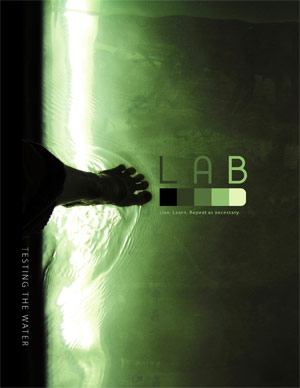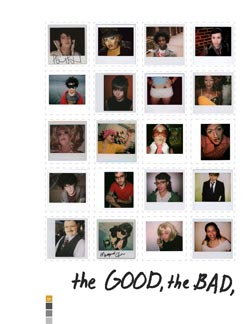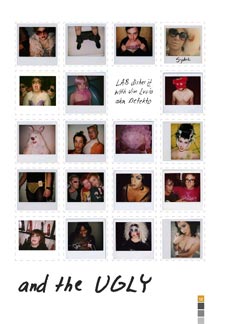LAB: You’ve been doing portraits for over 20 years. When did you first start using Polaroids?
JL: The first Polaroid I took was with a friend’s camera around 1983. I think it was with a cheap Sun camera, but I fell in love with it nonetheless. I got my own a couple of years later.
You use both film and digital. Do you find that those formats influence your style in different ways?
Absolutely. With my digital camera I am much more out for the candid shot and really try to avoid posing people unless it is for something specific, like band shots, or some element to a poster or graphic design project. Many times I don’t even bother looking through the viewfinder because I can get more interesting angles and people less expecting their photo to be taken, and I prefer those over the ones where people are all too aware of the camera. But with the Polaroid, I am much slower and calculating about the angle, head position, background, expression and so on.
There’s a certain undeniable instant-gratification to Polaroids. Which seems to work well with your subjects— at parties, clubs, parades, concerts. Do people respond differently to your Polaroid camera vs your digital?
People do get excited about the Polaroids, and because I’m known in certain circles here in Baltimore as the guy who takes Polaroids, there is sometimes an element of excitement and, “Oh, Defekto took my Polaroid!” People are also less intimidated by a cheap looking Polaroid camera than a more professional-looking camera. And that helps when Polaroiding because I am right in their personal space, 1–2 feet away. But people in general just enjoy having their photos taken, so it’s flattering no matter what camera one uses. It satisfies their ego and makes them feel good, especially if they are out and took some time getting themselves together.
Your photography captures a certain cross-section of Baltimore’s scene. Your shots of merry-makers are simultaneously fabulous & seedy, glamorous & raunchy, everything from the shy wallflowers to the saucy drag queens. A fascinating slice of life that seems to be somewhat subverting traditional Beauty (with a capital B). Discuss.
A dented Cadillac is much nicer to me than one that has just been driven off the lot. My choice of subjects is really just me expressing what I like. It’s what I think is beautiful and interesting. I identify more with the weirdos, so by default they also become the subjects I’m most interested in. I do appreciate traditional beauty, but I like to surround myself with what might not always be considered tasteful or visually stunning. Everyone deserves their moment and I am more apt to give it to the people who I think would be overlooked. And in the process, I somehow manage to make all of my subjects look glamorous no matter who they are or what they look like.
Have you had any issues with your work being labelled lowbrow or scandalous?
I don’t like to label people or my work, but I’m sure there would be people quick to call some of what I do lowbrow. In fact I started a group on Flickr called LOWBROW! I got the inspiration after I realized how much people ate up images of beautiful nature shots, kitty cats, ladybugs and any number of uninteresting and extremely boring subjects. I’m not trying to make high art, but if in the process someone wants to call it that, that’s fine with me. I consider myself a documentarian, then a photographer, so if someone says that my work is scandalous, then it’s more of a comment on humanity than my work.
That makes sense. You’re basically documenting a certain scene, a certain slice of Baltimore. I’ve seen the LOWBROW group on flickr— fun stuff. A good antidote to all the uber-sweet stuff. And interesting you should talk about the popularity of the kitty cats & ladybugs— I call it the Puppies, Sunsets, and Rainbows Syndrome. What’s your take on the popular tendency towards all things vanilla & supercute?
I think people need to belong to something, whether it be a religious group, an online community or even that strange group of men who wear chinos and untucked long-sleeved dress shirts with flip flops. There are others like them and that makes people feel like they are counted and that contributes to the whole homogenization, the blanding, of America. We don’t need another Starbucks or McDonalds, yet people want them— don’t even get me started— I’m actually appalled that Starbucks is branching out so far beyond coffee that they feel the need to sell music and are now getting into the movie business and publishing too. It’s disappointing that so many people will sacrifice their individuality to conform. It’s like, why bother going to the cool indie record or bookstore when you can just get your stupid skinny latte and pick up the new cd and book that Starbucks is currently promoting? All in the name of quality and good taste… it’s so limiting. I think this homogenization creates intolerance and ignorance, but on the upside, it makes finding the people who are interesting a lot easier.
What have been some of your influences? Being from Baltimore, you must get some John Waters comparisons, no?
I’ve heard people say, “This is so John Waters.” Those comparisons used to bother me… even before I lived in Baltimore. Sometimes it’s inevitable, like when I shot a drag queen hovering over a body that is bleeding pork & beans… there just aren’t very many people who would do that, and maybe John Waters would, but so would I. I love his early films and am probably somewhat influenced because I saw them when I was a teenager, but more than that I would say we simply share similar sensibilities. My major influences are Andy Warhol, Diane Arbus, and PT Barnum.
Any plans for a film project?
Years ago I used to want to be a filmmaker. I made my share of Super 8 psychodramas and wrote a lot. Those aspirations were put on hold and then forgotten for a long time, but lately I have been thinking of planning a short animated film, but there’s so little time in the week, I don’t know if I can. I need a benefactor.
Ah. Yes. Calling all benefactors! Maybe we should have a Benfactors Wanted section in the back of LAB. I’m only half-joking. So your bio mentions that you’re a graphic designer & party promoter. Could you talk a little bit about the work you do with Flux Studio? And what does being a party promoter involve?
Flux Studios is a very new venture. My boyfriend, Jeremy Crawford, and I curate art shows and I will be using it as a photo and design studio. When we moved to Baltimore from New York four years ago, I couldn’t find any work so on a whim I started throwing parties under the name Sideshow! I began booking bands, hired a DJ, and cast friends in theatrical roles to liven up the atmosphere. I went into the whole party-promoting thing as kind of an art project. I almost didn’t care if anyone liked it, I just wanted to have fun doing it, and laugh at the results. Now, my favorite thing to do is to get a group of friends to form a band that doesn’t exist and promote it Barnum style, “First East Coast Appearance!” They practice a few times and meanwhile I promote them as if they were the Beatles and everyone comes out for it. It’s such a satisfying prank. You have heard of Joyce
But of course! That’s the hot new phenomenon from Baltimore, right?
She’s very hot right now! As is Wayne Mutant and Meat Vegan.
You spent some time designing backgrounds at Nickelodeon for Blue’s Clues. What was that like?
I loved working on the show. It was a really cool place to be and watch it just explode, but it became such a marketing giant that the selling of merchandise and toys overshadowed the actual production of the show and that’s when it stopped being fun for me, so I left. In fact, the experience turned me off to work in general and New York City is all about work, so we decided to move to Baltimore. I would love to be a part of that kind of creative atmosphere again, but I don’t know if it would mean as much to me unless I create it myself. A friend and I talk occasionally about putting a pilot together to pitch for a show of our own, so maybe soon we can actually start working on that.
It seems a certain essential ingredient in your work is being able to approach people. I’ve done some candid street photography, and I know it takes a certain skillset to ask random strangers to allow you to take their photo; it’s not just all Point & Shoot. What’s your secret to establishing a rapport or degree of trust with random strangers?
Of the hundreds of random strangers I’ve photograhed, I could count the number of people who refused to have their photo taken on one hand. It does take a degree of nerve to just walk up to someone, and if I feel that they may reject me, I usually try to talk to them about something else then ask for the photo. When asked why or what it’s for, I usually just tell the truth— because they look fantastic. It’s harder to do on the street, especially if someone seems to be in a hurry to get somewhere, but if it’s in a bar or club, people are relaxed and not going anywhere and that makes it much easier.
One of the taglines on your website ( defekto.com ) is: The Good, The Bad, and The Ugly. Your aesthetic seems to be the opposite of Hear No Evil, See No Evil. Have there been any photo shoots that have just been too gruesome, too raunchy, too fugly for you to post? Does anything end up on the cutting floor, and, if so, why?
I don’t leave much on the cutting room floor. I wouldn’t shoot it to begin with if I thought it was too much. I don’t think I’d photograph an accident or something that was exploitive or emotionally painful to the subject, but I don’t care if someone sees a photo of mine and is offended by it because they think it’s distasteful.
I met this exhibitionist once and I posted a few of his photos online. Some people that was a bit much… but, then again, I think photos of dew drops on flowers are a bit much.
For the Flickr users out there who know you by the name Defekto… what are the origins behind the name?
I originally came up with the name Defekto when I was trying to think of a word to use as a domain name. Everything was taken so I had to make one up. I liked it because it conveyed an element of defectiveness or something not being right and that’s a feeling I get with my work. I’m not about perfection in either my photo or design work. The first time someone walked up to me and asked if I was Defekto, I realized that the name was more than just a website, it was me.
It is catchy. Sort of like the opposite of Perfecto. And it works as an adjective, too: “That’s so defekto.” Any plans for Defekto swag?
Defekto is kind of developing as its own brand. A style, an attitude, slightly distasteful yet compelling… I should have my own fragrance. The bottle could be shaped like a little garbage can. There will probably be T-shirts in the near future, mostly to satisfy my graphic urges. A friend suggested I open a modeling agency called Defektiv Models… I would love that.
You recently hung a gallery show. Do you have any big projects on the horizon? A book?
My first big show consisted of 365 Polaroid portraits that I took over the course of a year in Baltimore and I would love to photograph the people in another city, maybe Detroit or Las Vegas. I have no doubt there will be a book at some point and a guy here in Baltimore has expressed interest. I am open to discuss the first Defekto book with any interested publishers. ¤



